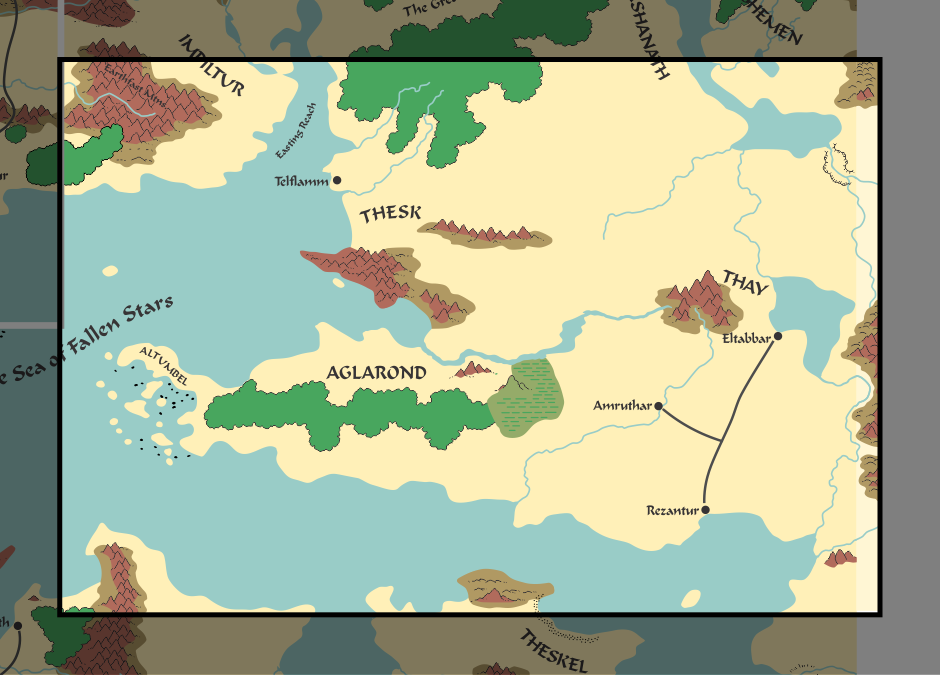Off To See the Red Wizards
 The sixth FR-series supplement headed east, extending the detail maps of the Forgotten Realms another panel to the east of the original boxed set ones (while jogging slightly south), and hit the eastern edge of the large map in the process. This centered the book on one of the peripheral villains of the setting, the Red Wizards of Thay. The Wizards themselves remain popular villains (including a 5e adventure series that echoes the title of this book), and the general area has been revisited in Spellbound and Unapproachable East.
The sixth FR-series supplement headed east, extending the detail maps of the Forgotten Realms another panel to the east of the original boxed set ones (while jogging slightly south), and hit the eastern edge of the large map in the process. This centered the book on one of the peripheral villains of the setting, the Red Wizards of Thay. The Wizards themselves remain popular villains (including a 5e adventure series that echoes the title of this book), and the general area has been revisited in Spellbound and Unapproachable East.
The module returns to the normal layout: 64-page detached book in brown ink with faux-parchment background, one poster map, and no printing on the inside cover. The east edge of the map just barely shows some of the Sunrise Mountains, another convenient chain that defines the edge of the known lands of the Realms (there’s only a bit of hint of foothills on the boxed set’s 90 mi/in maps, meaning this map actually goes slightly off the edge of that map). While there’s some very nice Valerie Valusek illustrations, and a reproduction of the main map in the book, there’s no detail maps to be had (perhaps because the Red Wizards forbid any maps to be made of their cities…).
While Thay is actually only a part of the area covered, they are front and center in the book, even when they aren’t (the ‘History of Thay’ and ‘Geography of Thay’ sections actually cover a lot of things outside of Thay). Surrounding countries are largely defined by how prepared they are, or who they typically ally with, to fight off Thay when they inevitably invade. Make no mistake, Thay is an evil country; expansionist, power-hungry, and with an economy built on slave labor. It’s made clear that not everyone is evil (just like a ‘good’ country doesn’t have an entirely ‘good’ population), just everyone in charge is.

Region the FR6 map covers. The pale section on the right is where it sticks past the original 90 mi/inch map area.
Overall, Thay is given a well-rounded presentation. There’s no ‘rule of law’, just tradition and pronouncements, no one system of taxation (merchants going through one city are effectively ‘taxed’ by the Thieves Guild…), but there is administration. The Tharchions handle the ordinary running of the country, and defer to the Zulkirs (the top Wizards) when they intervene. With a bunch of high-level magic-users in charge, one might wonder how Thay isn’t much bigger than it is, especially since most of its neighbors don’t have the ability to resist that sort of firepower. But the Zulkirs aren’t a united group, and often work against each other to prevent any one from becoming too powerful, moreover there are some who would rather research, and not deal with wars disrupting trade in rare spell ingredients. And the economy is changing, with an emerging middle-class that the powers that be are uncertain about.
Late-era 1e AD&D seems to have gotten an inclination to keep adding new spells to the system. Focused on a set of wizards, FR6 naturally spends ten pages on new spells more-or-less unique to the Red Wizards. This could have been great, if the spells had a bit more flavor, like many of the ones in FR4 had. Unfortunately, many of these actually borrow from existing Cleric and Druid spell lists, with minor changes (different levels, different component requirements, and slightly different effects), making it feel more like they are destroying the essential flavor of those classes instead of adding anything new. Also, the largest section is for Abjuration (protection) spells, the bulk of which are variations on the theme of ‘Protection From [Effect/Creature]’. This could allow a Red Wizard to be annoyingly difficult to deal with, if he knew which spells to memorize beforehand.
There is also an eight-page player’s guide to Thay. Instead of the well done in-world introductions of the Gazetteer series, the bulk of this is taken up by giving the available spells to learn if you’re a magic-user studying in Thay, or are from Thay. For a campaign visiting the mysterious country for the first time, half the player’s guide needs to be hidden away. But the first sections are a handy player-facing glossary, and a set of rumors. The latter are followed up in an adventuring section that gives further information and inspiration on what to do with them (this is much better than the usual approach that can leave you wondering what the author was thinking about). Thay is currently involved in two different wars, and a few other activities that adventurers could easily get involved in.
The big problem with Dreams of the Red Wizards is that Thay is a long way away from the usual adventuring grounds of the Forgotten Realms line, and the book wanders between presenting it as a possible campaign site, and trying to figure out how to draw existing adventurers from further west into range of the material presented. Furthermore, the power structure of Thay is primed to be rife with intrigue and deadly politics, but very little is really said about that, making an internal-view campaign difficult to set up. This isn’t as good as the highlights of the series (Waterdeep and the North and The Savage Frontier) as it doesn’t have the same ‘sufficient unto itself’ feel, but despite the problems, still presents a lot of material very well.

Discussion ¬